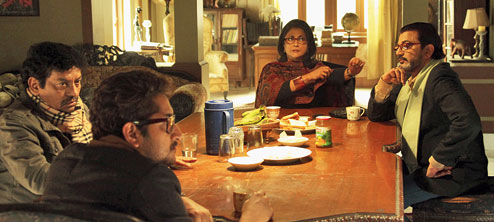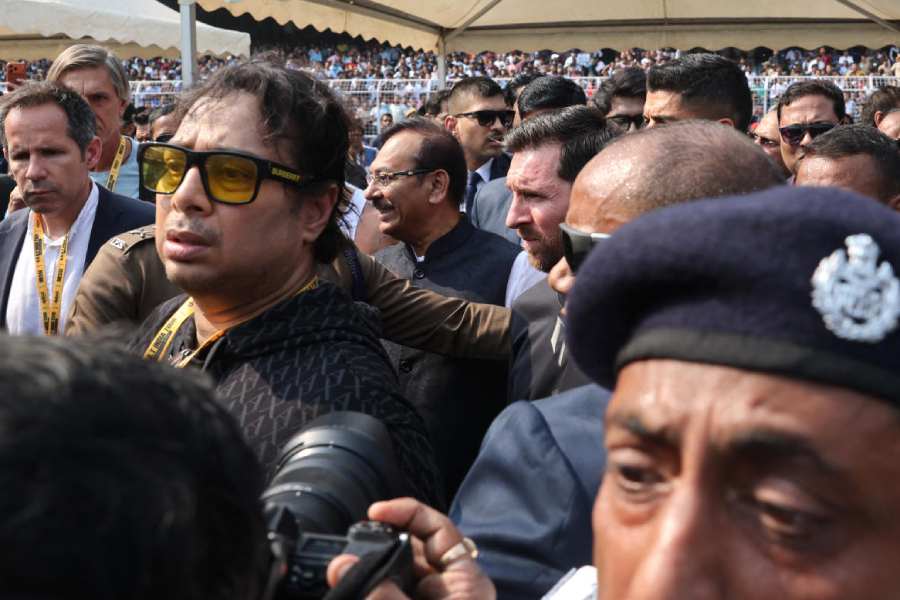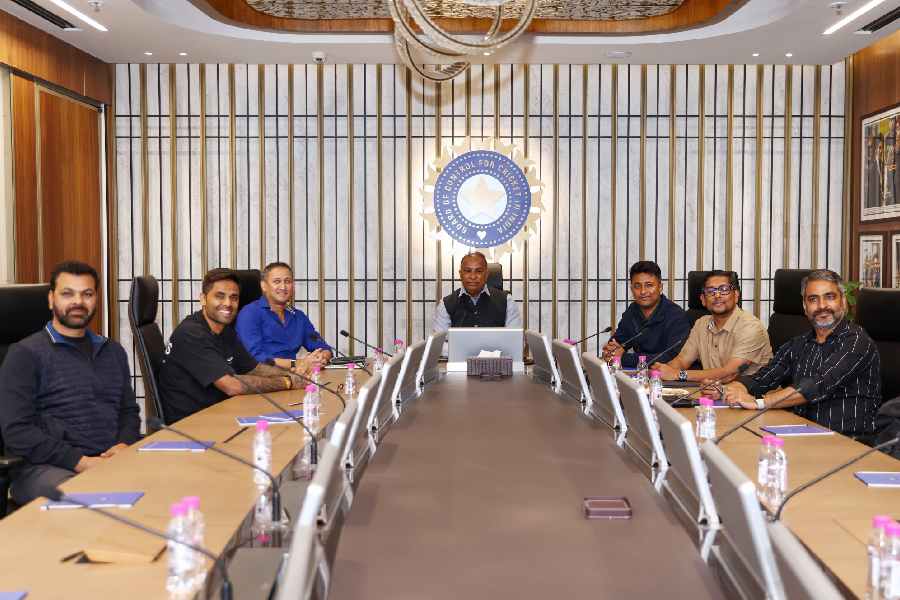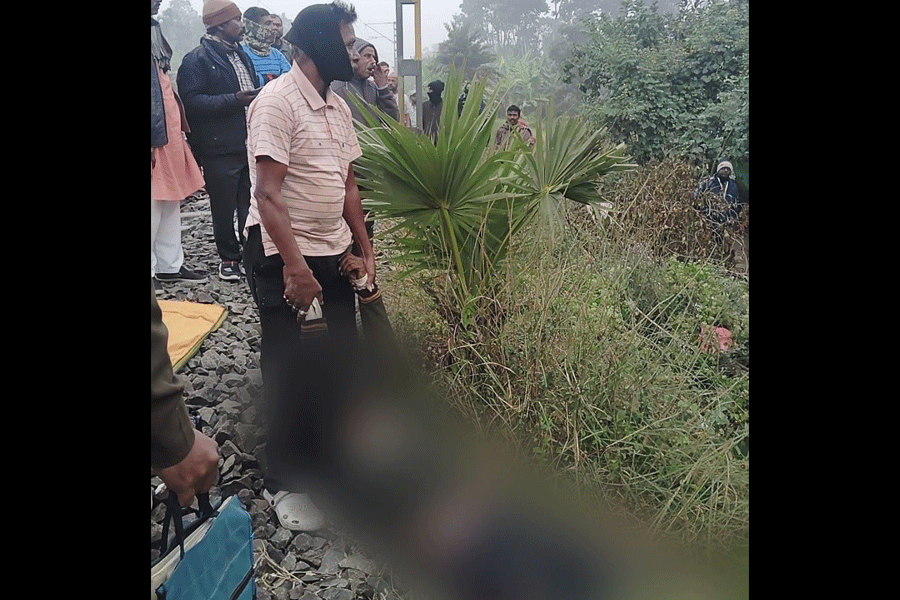 |
| Parambrata Chattopadhyay, Goutam Ghose, Aparna Sen and Chiranjit in Chotushkone |
A film about films is an idea filmmakers can’t resist. It’s the world they belong to and there is no doubt that it is fascinating for filmmakers and audiences alike. Srijit has made one hell of a quirky movie. If I had to use a few words to describe Chotushkone I’d pick — unabashed, stylish, raw, hilarious, self-reflexive, clever and most importantly self-confident as a ************ (go figure!).
I’d rather not discuss the story because this movie is really not about the story but at the same time, it so much is about the story that I’d be writing a spoiler. Let me try to start at the basics: A film director, Joybrata (rhymes with and played by “Parambrata” Chattopadhyay) receives an offer from a producer who wants to make a feature film out of four short films made by him and three other directors: Trina (rhymes with and played by “Rina” a.k.a. Aparna Sen), Shakyo (played by Goutam Ghose) and Diptya (played by Chiranjit a.k.a. Dipak Chakraborty). The conditions are that they have to act in their own short films; travel to the producer’s bungalow in a jungle to give him a narration; and the short films need to have a common theme — Death.
Since Diptya and Trina have had an affair in the past with Shakyo being the silent third angle, Joybrata has difficulty convincing them but eventually succeeds. So they set out on a journey, narrating their stories while rediscovering aspects of their past and present relationships in their respective lives. Srijit weaves in very edgy and out-of-the-box stories for the films within the films, with my personal favourite being Diptya’s story about a guy who goes to obsessive lengths for cigarettes.
Trina’s story about a reverse planchet is fascinating and Shakyo’s story about how a TV serial writer kills off characters and how those characters come to take revenge on him is reminiscent of Woody Allen’s Deconstructing Harry and I must say Srijit pays a lovely homage to the director. The worst part about writing about this film is that the more I would like to discuss it, the more I’ll end up giving away stuff.
So let’s just say that the film reaches a climax and a tragic end when Joybrata tells his story and we discover that he is related to all three, uncovering terrible secrets from their past. So, in a nutshell, it is one film with one story which is about a bunch of stories and Srijit manages to balance them with perfect craftsmanship. The film basks in over-indulgence and that’s the fun of the movie.
When you have a script filled with well-defined characters, it’s a field day for the actors, and once again our city proves that we aren’t short of good performers.
Chiranjit’s role is one of the finest comebacks I’ve seen in recent times. Parambrata once again proves how indispensable he is as an actor and the last 25 minutes belong to this boy wonder. Goutam Ghose is a fun treat; Aparna Sen has her distinct moments and Kaushik Ganguly gets a “two thumbs up” for lighting up the screen in one scene. Koneenica (Banerjee) was charming, the gorgeous Paayel Sarkar created beautiful chemistry with Indrashish and Neel Mukhopadhyay was fascinating. Arpita Chatterjee was breathtaking; Barun Chanda’s last smile spoke a thousand words and Biswajit Chakraborty, Debleena Dutta, Ritabhori delivered to the T.
Anupam Roy’s songs were, as always, a delight. Bawshonto eshe geche is one of my personal favourites (Lagnajita Chakraborty, the singer, is a discovery), while Boba tunnel was beautifully reminiscent of his signature style.
Rabiranjan Maitra seamlessly put together so many stories running at the same time, which is a tough job for an editor; while Sudeep Chatterjee’s camera work along with Saswati and Mridul Karmakar’s art design complement the quirky universe of Chotushkone.
I just wished Srijit had fleshed out Aparna Sen’s character graph a little more, or rather, as much as the others. Also, Chiranjit’s estranged son’s love story with Mimi, though superbly performed by Koneenica, felt a little out of place in the larger scheme of the film.
As a final thought, the whole fun of independent cinema and what Bengal has always been known for is its ability to push boundaries. Chotushkone pushes many. The lack of safe-playing makes this film unique. And in a day and age in which somehow the history of Bengali cinema stops at Ray for most people, it’s nice to see a film buff bring in all kinds of references from Beder Meye Josna to 36 Chowringhee Lane which are also now recorded in history through this film.
Bengal has had an interesting filmography outside Satyajit Ray, Ritwik Ghatak and Mrinal Sen and it’s nice to know Srijit loves the wider canvas of Bengali films and wants to pay tribute to them. Interestingly Rituparno Ghosh who was supposed to be a part of the film, was an encyclopedia of Bengali cinema and he may not have been there in person, but his love for Bengali cinema and the Bengali film world lives on through the spirit of the film.











